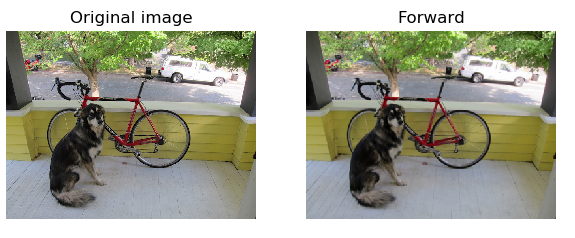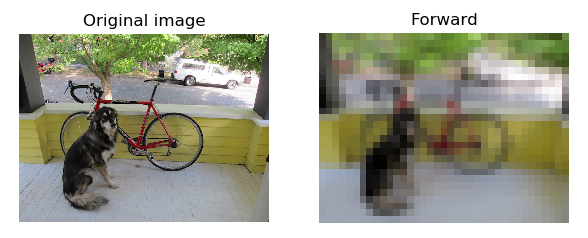Avgpool layer
- class layers.avgpool_layer.Avgpool_layer(size, stride=None, pad=False, input_shape=None, **kwargs)[source]
Bases:
NumPyNet.layers.base.BaseLayerAvgpool layer
- sizetuple or int
Size of the kernel to slide over the input image. If a tuple, it must contains two integers, (kx, ky). If a int, size = kx = ky.
- stridetuple or int (default=None)
Represents the horizontal and vertical stride of the kernel (sx, sy). If None or 0, stride is assigned the same values as size.
- input_shapetuple (default=None)
Input shape of the layer. The default value is used when the layer is part of a network.
- padbool, (default=False)
If False the image is cut to fit the size and stride dimensions, if True the image is padded following keras SAME padding, see references for details.
>>> import os
>>> import pylab as plt >>> from PIL import Image >>> >>> img_2_float = lambda im : ((im - im.min()) * (1./(im.max() - im.min()) * 1.)).astype(float) >>> float_2_img = lambda im : ((im - im.min()) * (1./(im.max() - im.min()) * 255.)).astype(np.uint8) >>> >>> filename = os.path.join(os.path.dirname(__file__), '..', '..', 'data', 'dog.jpg') >>> inpt = np.asarray(Image.open(filename), dtype=float) >>> inpt.setflags(write=1) >>> inpt = img_2_float(inpt) >>> >>> inpt = np.expand_dims(inpt, axis=0) >>> pad = False >>> >>> size = 3 >>> stride = 2 >>> >>> # Model initialization >>> layer = Avgpool_layer(input_shape=inpt.shape, size=size, stride=stride, padding=pad) >>> >>> # FORWARD >>> >>> layer.forward(inpt) >>> forward_out = layer.output.copy() >>> >>> print(layer) >>> >>> # BACKWARD >>> >>> delta = np.random.uniform(low=0., high=1.,size=inpt.shape) >>> layer.delta = np.ones(layer.out_shape, dtype=float) >>> layer.backward(delta) >>> >>> # Visualizations >>> >>> fig, (ax1, ax2, ax3) = plt.subplots(nrows=1, ncols=3, figsize=(10, 5)) >>> fig.subplots_adjust(left=0.1, right=0.95, top=0.95, bottom=0.15) >>> >>> fig.suptitle('Average Pool Layer
- size{}, stride{}, padding{}’.format(size, stride, pad))
>>> >>> ax1.imshow(float_2_img(inpt)[0]) >>> ax1.set_title('Original image') >>> ax1.axis('off') >>> >>> ax2.imshow(float_2_img(layer.output[0])) >>> ax2.set_title('Forward') >>> ax2.axis('off') >>> >>> ax3.imshow(float_2_img(delta[0])) >>> ax3.set_title('Backward') >>> ax3.axis('off') >>> >>> fig.tight_layout() >>> plt.show()


- backward(delta)[source]
- <<<<<<< HEAD
Backward function of the average_pool layer: the function modifies the net delta
Backward function of the averagepool layer: the function modifies the net delta
- >>>>>>> bc4153f58a054d4e60bb14c993bf61a058458e8b
to be backpropagated.
- deltaarray-like
Global delta to be backpropagated with shape (batch, out_w, out_h, out_c).
self
- forward(inpt)[source]
Forward function of the average pool layer: it slide a kernel of size (kx,ky) = size and with step (st1, st2) = strides over every image in the batch. For every sub-matrix it computes the average value without considering NAN value (padding), and passes it to the output.
inpt : array-like
- <<<<<<< HEAD
Input batch of image, with the shape (batch, input_w, input_h, input_c).
Input batch of images, with shape (batch, input_w, input_h, input_c).
>>>>>>> bc4153f58a054d4e60bb14c993bf61a058458e8b
self
- property out_shape
Get the output shape
- Returns
out_shape – Output shape as (batch, out_width, out_height, out_channels)
- Return type
tuple